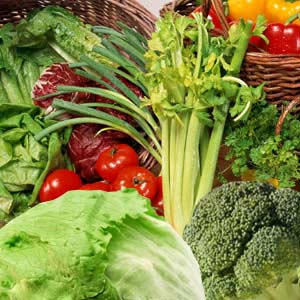Raw Food Diet

The sole purpose of eating is to attain physical fitness for healthy survival. Proponents of raw food diet believe in accomplishing this only by way of eating raw food. Referred as raw foodists, they earnestly abide with nature, and believe in the power of eating raw, living food. The raw food concept isn't new but an age-old tradition followed by primitive man, a nutritional food habit that contributed immensely for the state of his health.
Raw food is also termed as living food. It is a movement that originated in America. The diet consists of living enzymes, valuable vitamins, phytochemicals and other things that can prevent many health problems, promote health and strengthen the immune system in a noticeable manner. Devoid of the steps involved in cooking, raw food eaten as it is, extracts all nutritional elements in its natural form. Deciding to consume raw food is a perfect launch pad to refine health.
Raw food - 75% of diet
The purpose in adhering to a raw food diet regime is to enhance the nutritional value of food consumed. Different versions of raw food diet exist across the globe. For instance, raw food diet followers in Germany keep away from cereals and dairy products. Mixing of some food with other foods is strictly not followed and only a single food is eaten.
One popular version of raw food diet consists of food that is predominantly or exclusively uncooked and unprocessed. Organic plant-based foods too are considered as raw food. Fruits, nuts, seeds, sprouted grains, greens and beans are the main components of raw food diet. Typically a vegan diet, animal products do not find place in a raw food diet.
However, it is impractical to eat a diet that comprises 100% raw food. Nutrition experts too warn against adhering to a 100% raw food diet, as it can be too low in protein. It is potentially dangerous to the body. On the other hand, consuming 75% of the diet as enzymatically alive, raw, whole, live uncooked food is favorable. The body is capacitated to eliminate the toxins in the cooked food, which constitutes the remaining 25% of food.
The ideal raw food diet should consist of raw foods that have been heated via a dehydrator, at a temperature not exceeding 116 degrees. When food is heated above 116°F, vitamins are significantly reduced.
The natural enzymes in food that support voluntary digestion are damaged or completely destroyed during the process of heating. This can lead to forced usage of the body's own cellular enzymes in order to complete digestion. Rapid signs of aging, feeling fatigue, illness and unwanted fat storage in the body can be related to exhaustion of body's enzyme-producing glands.
Selecting, preparing raw food
The list of beverages consist of unpasteurized milk, purified water, freshly made fruit and vegetable juices, milk from a young coconut and tea. But the diet says a strict no to beer and liquor.
Apart from blending, juicing and chopping, the other techniques that are followed in preparing raw foods include sprouting seeds, grains and beans; soaking nuts and dried fruits; and juicing fruits and vegetables. A dehydrator is the only equipment that is used for cooking food. Hot air blows through the food and the temperature is not supposed to reach or exceed 116°F.
- Fresh fruits and vegetables
- Nuts, seeds, beans, grains, legumes
- Dried fruits
- Seaweed
- Sun-dried fruits
- Organic or natural unprocessed foods
- Unpasteurized dairy products
Raw food diet benefits
- Food is raw and rich in naturally occurring enzymes
- Food is whole; not processed or refined
- Food is high in natural vitamins and minerals
- High fiber, low calorie helps guard obesity
- Assists in improved appearance of skin
- Easier to digest (live enzymes)
- Reduces risk of heart disease
- Higher energy levels
Plan raw food diet
For maximum benefits, try to plan your meals in advance so as to ensure maximum amount of nutrients required for your body. Also, eating fruit early in the day helps in improving digestion as well as contributes in boosting energy levels. Take due notice of nutritional deficiencies that may occur on the raw food diet. This includes calcium, iron, B12, protein and calories. Discuss with your health care provider and find supplements to compensate the same.
Top of the Page: Raw Food Diet
Tags:#raw food #raw food diet

Therapeutic Lifestyle Changes Diet
Intermittent Fasting Plan
Flexitarian Diet
Dukan Diet Plan
Diet Plateau
High Protein Diet
Elimination Diet
Raw Food Diet
Paleo Diet
Liver Cleansing Diet
Intermittent Fasting Diet
Low Fat Low Cholesterol Diet
Low Carb Diet
Vegan Diet Plan
Hay Diet
Sacred Heart Diet
Heart Attack Diet
Diet after Gastric Bypass
RICE Diet
Gluten Free Diet
Acid Reflux Diet
Detox Diet
Sonoma Diet
Glycemic Index Diet
Montignac Diet
Diabetic Diet Plan
Healthy Breastfeeding Diet
Negative Calorie Diet
Fad Diet
Blood Group Diet
Diverticulitis Diet
DASH Diet
Ornish Diet
3 Day Diet Strategy
Ketogenic Diet
Zone Diet Plan
Anti Aging Diet
South Beach Diet
Gall Bladder Diet
Low Cholesterol Diet
Low Sodium Diet
Diet and Kidney Disease
Scarsdale Diet Plan
Macrobiotic Diet
Osteoarthritis Diet
Depression Diet Plan
Migraine Diet
Restricted Salt Diet
Gout Diet
Rotation Diet
Diet Cancer Patient
Ways to better Health

Boost Metabolism
BMI Calculator
Low Fat Dessert
Whey Protein
Diet and Fitness
Fitness Exercise Articles
Cardio Workout
Aerobics
Yoga
Body Toning
Top of the Page: Raw Food Diet
Popularity Index: 101,579

